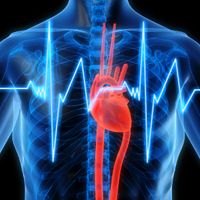Effect of Antithrombotic Therapy on Stroke and Bleeding Risk in Low-Risk Atrial Fibrillation Patients
Patients with atrial fibrillation at low risk of stroke treated with antithrombotic agents experienced low rates of stroke-related events, but the rate increased significantly in patients with even one additional risk factor.

Analysis of records from nearly 40,000 people with atrial fibrillation (AF) indicates that physicians should use antithrombotic agents to prevent strokes in all AF patients who have any additional risk factors other than being female.
The benefits of stroke reduction greatly exceeded the small risk of serious bleeds formen with CHA2DS2-VASc scores of 1 or more and women with CHA2DS2-VASc scores of 2 or more, according to lead investigator Gregory Y. H. Lip, MD.
Results from the study appeared in the Journal of the American College of Cardiology, along with an editorial that was less confident than Lip about the benefits of providing oral anticoagulants to patients with a CHA2DS2-VASc score of 1.
Physicians who follow such advice would automatically recommend treatment to all patients aged 65 and over — no matter how good their general health — and to all younger patients with hypertension, diabetes or any history of cardiovascular disease.
Lip and his colleagues created their cohort retrospectively, by linking the records of 39,400 AF patients from the Danish Civil Registration System, the Danish National Patient Register, and the Danish National Prescription Registry.
All of the patients had CHA2DS2-VASc of either 0 or 1 and were thus considered to be low risk. More than half of them, 23, 572, received no treatment, while 5,353 of them received aspirin, and 10,475 of them received warfarin.
For untreated men with no risk factors and untreated women with none besides their sex, the calculated rate of strokes a year after initial diagnosis with nonvalvular AF was 0.49 per 100 patient years, while the rate of ischemic stroke was 0.43, the rate of bleeding was 1.08 and the rate of intracranial hemorrhage was 0.15.
The addition of 1 risk factor produced a dramatic increase in all the risks.
For untreated men with a CHA2DS2-VASc score of 1 and untreated women with a CHA2DS2-VASc score of 2, the rate of strokes at 1 year was 1.55 per 100 patient years, while the rate of ischemic stroke was 1.50, the rate of bleeding was 2.74, intracranial hemorrhage was 0.36.
For similar patients treated with aspirin, the rate of strokes and ischemic strokes was 1.45 per 100 patient years, while the rate of bleeding was 2.31 and the rate of intracranial hemorrhage was 0.20. For similar patients treated with warfarin, the rate of strokes was just 1.06 per 100 patient years, while the rate of ischemic strokes was 1.02, the rate of bleeding was 2.42 and the rate of intracranial hemorrhage was 0.44.
The benefits of treatment on mortality were even more impressive. For untreated men with a CHA2DS2-VASc score of 1 and untreated women with a CHA2DS2-VASc score of 2, the rate of death at the 1-year follow-up mark was 11.3 per 100 patient years. For patients treated with aspirin, it was 5.66. For those treated with warfarin, it was 4.00.
According to Menno Huisman, MD, who penned the editorial, the problem is that different analyses on different groups of patients have reached very different conclusions about the actual annual stroke risk for such patients.
Some have put the figure above 2%, which is above the 1.7% figure that is currently thought to justify the use of warfarin and well above the 0.9% figure that is thought to justify the use of novel oral anticoagulants.
On the other hand, other analyses of such patients have put the annual stroke risk for such patients as low as 0.6%, which is not thought to justify the use of any medication, Huisman wrote.